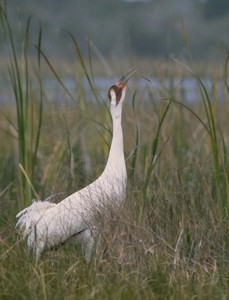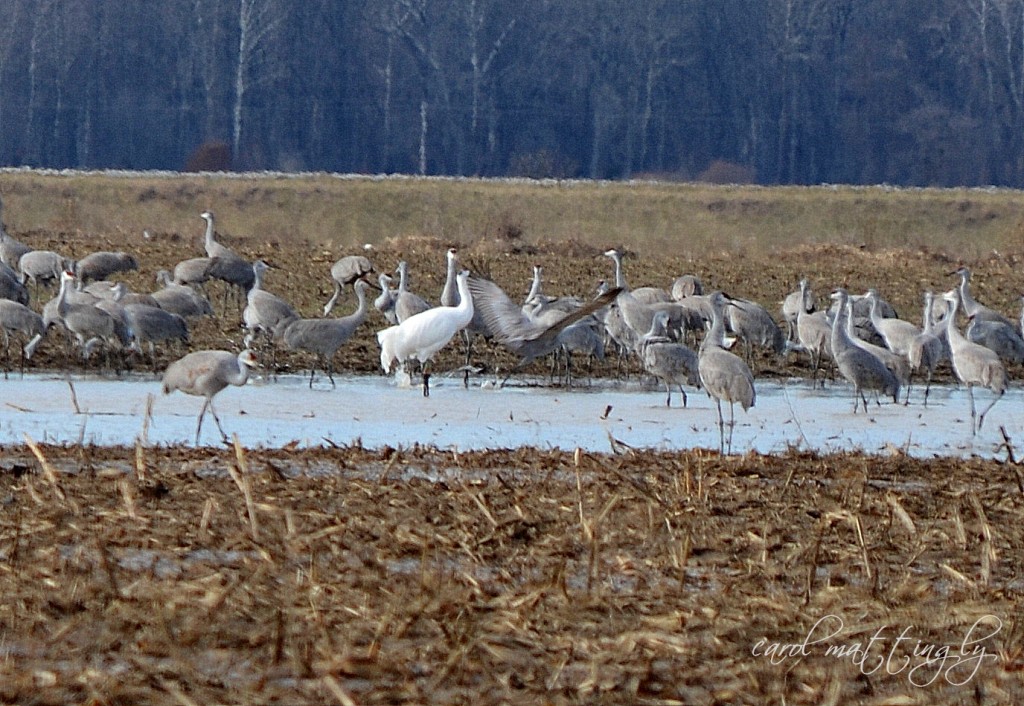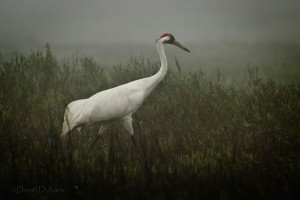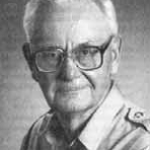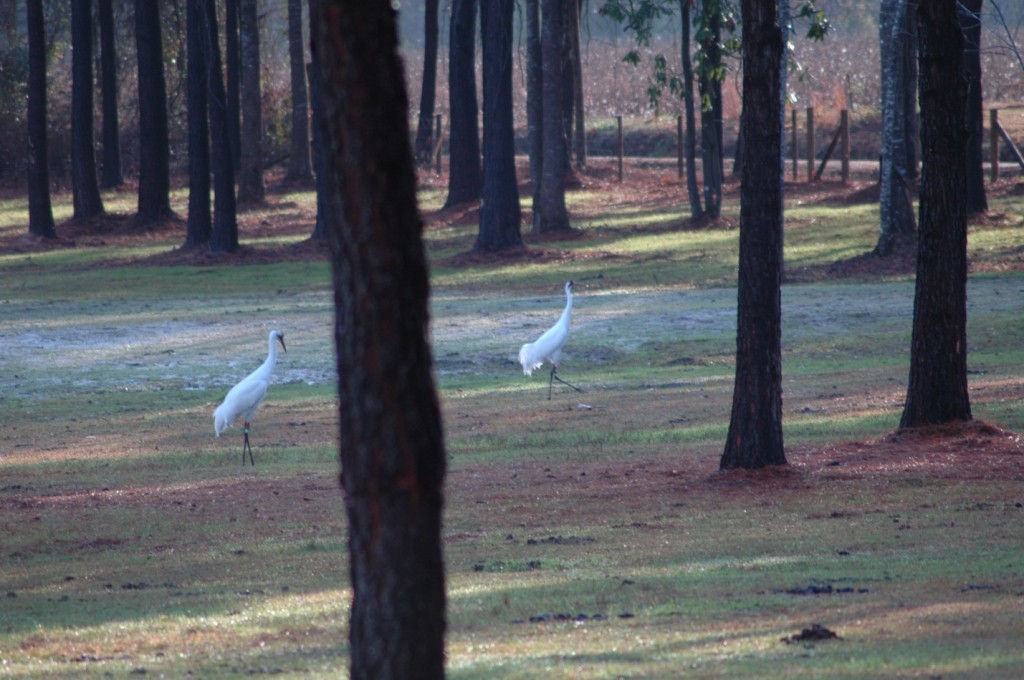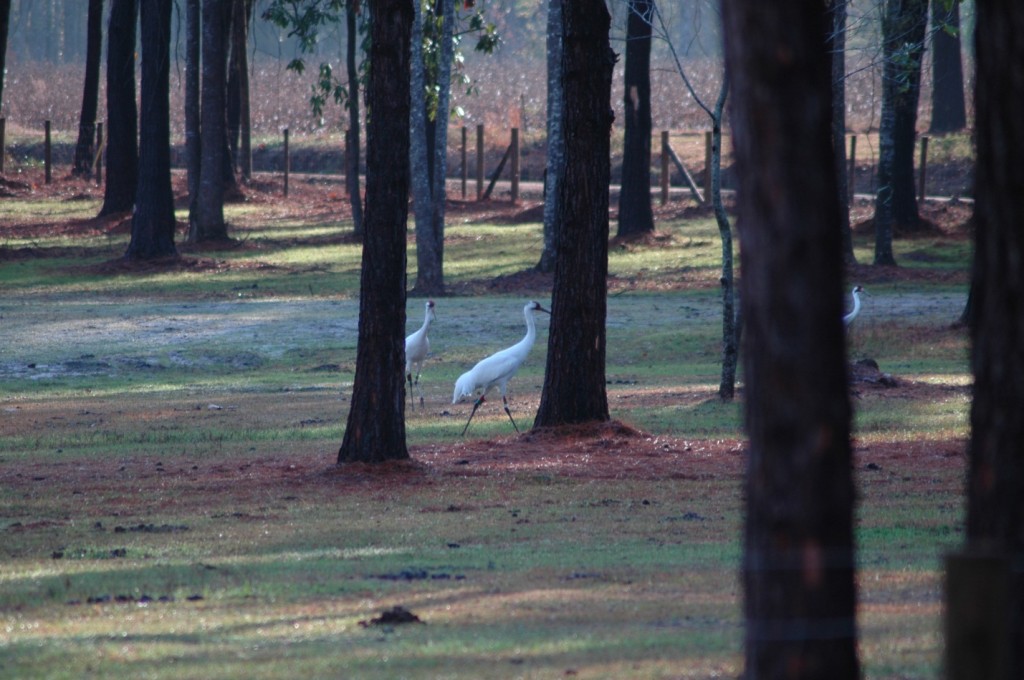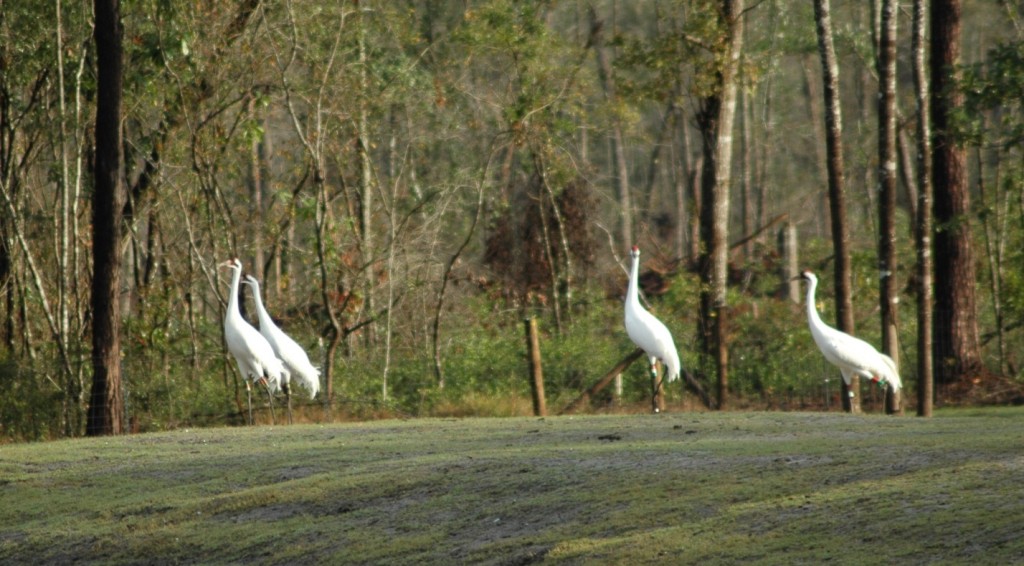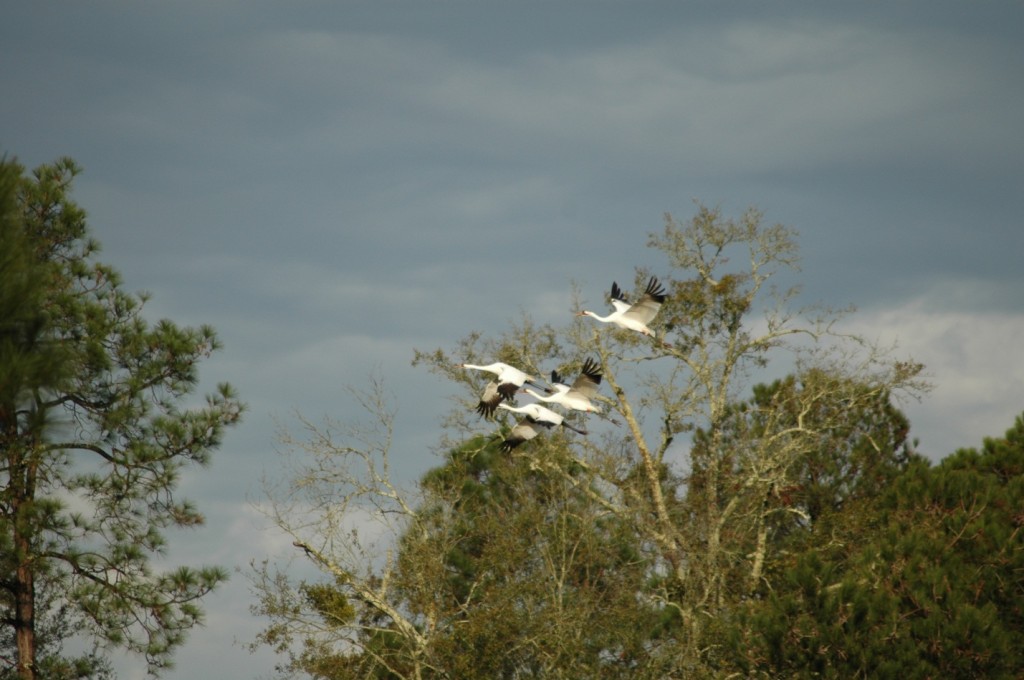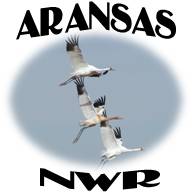Archive for the ‘Association News’ Category
Whooper Updates from The Aransas Project
February 16, 2013by Ron Outen, Regional Director, The Aransas Project, Feb. 16, 2013
USFWS Releases 2012-2013 Whooping Crane Estimate
USFWS has posted their 2012-2013 Winter Whooping Crane Survey. USFWS estimates the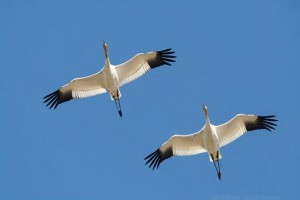 flock size to be 257 birds using their new distance sampling method. This estimate does not reflect an actual count of the flock size, but instead offers a 95% probability that the actual flock size is somewhere between 178-362 birds.
flock size to be 257 birds using their new distance sampling method. This estimate does not reflect an actual count of the flock size, but instead offers a 95% probability that the actual flock size is somewhere between 178-362 birds.
TAP issued this statement by Regional Director Ron Outen in response to the release of the estimate: “With the new flock-estimation methodology, there will be no more actual counts of individual birds. By their own analysis, USFWS offers a 95% probability that the actual flock size is somewhere between 178-362 birds. TAP remains concerned that the level of uncertainty with this sampling method is unacceptably high for a population this size. Additionally, the method fails to locate territories or detect mortality—all valid concerns raised by former Whooping Crane Coordinator Tom Stehn.
More fundamentally, the community—both locally and internationally—has come to expect an accurate count of the cranes and flock size year to year on the wintering grounds. We urge that USFWS reinstitute an actual census of the cranes in addition to this new methodology until it can be further peer reviewed and refined to ensure accuracy.”
Shootings of Whooping Cranes Highlight Other Risks to Flock
Two recent articles highlight the variety of threats faced by whooping cranes, both as they migrate to and from the wintering grounds in and around Aransas National Wildlife Refuge and once they arrive.
The Whooping Crane Conservation Association recently posted a release from the U.S. Attorney’s Office, District of South Dakota, entitled “South Dakota Man Guilty of Whooping Crane Murder.” The release detailed the sentencing of a South Dakota man who pled guilty to the April 2012 killing of an adult male whooping crane. The release notes that:
“The whooping crane killed in this case was one of about 300 wild whooping cranes that migrate from wintering grounds along the gulf coast of Texas to the Wood Buffalo State Park located in Alberta and the Northwestern Territories of Canada. This population of whooping cranes is the only self-sustaining population in the world.”
The plea resulted in the man being sentence to $85,000 in restitution, 2 years of probation, a $25 assessment to the Victim Assistance Fund, forfeiture of the rifle used, and a 2-year ban from hunting, fishing or trapping.
Closer to home,it was recently reported that a duck hunter turned himself in to a game warden in Aransas County in connection with the accidental shooting of a juvenile whooping crane in January of this year on St. Joseph’s Island. According to the report, the hunter believe that the juvenile was a sandhill crane, and turned himself in when he discovered that it was a juvenile whooping crane.
Former Whooping Crane Coordinator Tom Stehn notes that the Aransas National Wildlife Refuge is in the process of opening the Matagorda Island marshes to waterfowl hunting, and suggests that perhaps hunters should be required to take an online identification course to better protect the whooping cranes.
International Crane Foundation to Get $85,000 Restitution
February 14, 2013by Chester McConnell, Whooping Crane Conservation Association
On Friday, April 20, 2012, the Whooping Crane Conservation announced that a whooping crane from the Aransas/Wood Buffalo flock had been killed in South Dakota. This bird was a member of the only remaining wild flock of whoopers in the world. In 1950 only 14 cranes from this flock remained. They were carefully managed and protected by the U.S. Fish and Wildlife Service and Canadian Wildlife Service with assistance from the Whooping Crane Conservation Association. This flock has slowly increased and about 300 whoopers are in this flock today.
The Whooping Crane Conservation Association posted a $10,000 Reward for the conviction of any individuals responsible for the killing of the whooping crane (see Reward notice below). Later, U.S. Fish and Wildlife Service agents independently determined that Jeff Blachford, Miller, South Dakota had killed the whooping crane and Blachford was indicted by a federal grand jury on June 12, 2012.
Yesterday the hearing for Blachford was completed. United States Attorney Brendan V. Johnson announced that the Miller, South Dakota man pled guilty and was sentenced for killing an endangered whooping crane. Jeff Blachford, age 26, appeared before U.S. Magistrate Judge Mark A. Moreno on February 13, 2013 and pled guilty to one count of violating the Federal Endangered Species Act. Blachford was sentenced to $85,000 in restitution, 2 years of probation, and a $25 assessment to the Victim Assistance Fund. Blachford was additionally ordered to forfeit the rifle he used in the offense and is prohibited from hunting, fishing, or trapping anywhere in the United States for two years.
According to U.S. Attorney Meghan Dilges the $85,000 in restitution will be made to the International Crane Foundation.
The following Reward was posted by Whooping CranrConservation Association in April 2012:
Whooping Crane Shot – $10,000 Reward
by Chester McConnell, Whooping Crane Conservation Association
The Whooping Crane Conservation Association will pay a reward not to exceed $10,000 to anyone who provides information which leads to the conviction of any individuals responsible for the killing of a whooping crane which took place on the afternoon of Friday, April 20, 2012 along 354th Avenue, approximately 17 miles southwest of Miller, S.D. The purpose of the reward is to encourage the public to share information they might have about criminal activities involving whooping cranes. Federal, State, Provincial, and other public law enforcement personnel, and criminal accomplices who turn “states” evidence to avoid prosecution, shall not be eligible for this reward. If more than one informant is key to solving a specific case, the reward will be equally divided between the informants. 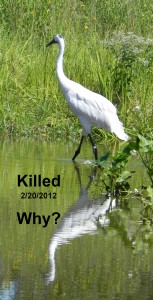
A reward has also been offered by the U.S. Fish and Wildlife Service for information leading to the arrest and conviction of the person responsible for the shooting of the whooping crane. Law enforcement officers from the Service and the South Dakota Game, Fish and Parks are investigating the shooting, which took place on the afternoon of Friday, April 20, 2012. The migrating adult whooping crane was traveling with two additional whooping cranes before being shot with a high-power rifle as it was standing in a corn field.
Anyone with information should call either the 24-hour “Turn in a Poacher Hotline” at 1-888-OVERBAG (683-7224) or the U.S. Fish & Wildlife Service at 605-224-9045 to report any information which will aid officers in the apprehension of the shooter. Callers can remain anonymous.
Eleven whooping cranes of the experimental Eastern Migratory population and non-migratory Louisiana population have been shot in the last two years. The Alabama case of January, a year ago, is still active. The Louisiana shootings have been solved by State Law Enforcement personnel and a reward will not be involved. One case is still active in Indiana.
The Whooping Crane Conservation Association will continue to provide rewards for killing of whooping cranes in the Aransas/Wood Buffalo flock.
South Dakota Man Guilty of Whooping Crane Murder
February 14, 2013Miller Man Sentenced for Killing endangered species
February 13, 2013, U.S. Attorney’s Office, District of South Dakota; Contact: Ace Crawford, 605-343-2913 ext. 2101
United States Attorney Brendan V. Johnson announced that a Miller, South Dakota man pled guilty and was sentenced for killing an endangered whooping crane.
Jeff Blachford, age 26, appeared before U.S. Magistrate Judge Mark A. Moreno on February 13, 2013 and pled guilty to one count of violating the Federal Endangered Species Act. Blachford was sentenced to $85,000 in restitution, 2 years of probation, and a $25 assessment to the Victim Assistance Fund. Blachford was additionally ordered to forfeit the rifle he used in the offense and is prohibited from hunting, fishing, or trapping anywhere in the United States for two years.
“Wildlife is an important resource to the people of South Dakota. This year marks the 40th anniversary of the Endangered Species Act, and the sentence handed down today for the senseless killing of a whooping crane, one of the rarest birds in the world, is a prime example of the enforcement of that law,” said Johnson. “The Department of Justice works hand in hand with the U.S. Fish and Wildlife Service and takes the killing of endangered species very seriously. Let this case serve as notice to anyone who thinks otherwise.”
In April 2012, Blachford shot and killed an adult male whooping crane approximately 17 miles southwest of Miller. “The killing of this whooping crane was a senseless act and the U.S. Fish and Wildlife Service is pleased with the sentence handed down in this case,” said Deputy Chief Edward Grace of the U.S. Fish and Wildlife Service Office of Law Enforcement. “The protection of endangered species is a high priority for the U.S. Fish and Wildlife Service and our Special Agents, in partnership with the South Dakota Department of Game, Fish and Parks, will continue to aggressively investigate these types of violations to ensure these animals receive the protection they need to survive.”
Whooping cranes are one of the rarest birds in the world with a total population of approximately 600 individuals. The whooping crane killed in this case was one of about 300 wild whooping cranes that migrate from wintering grounds along the gulf coast of Texas to the Woods Buffalo State Park located in Alberta and the Northwest Territories of Canada. This population of whooping cranes is the only self-sustaining population in the world.
This investigation was conducted by the U.S. Fish and Wildlife Service Office of Law Enforcement and the South Dakota Department of Game, Fish and Parks. Assistant U.S. Attorney Meghan N. Dilges prosecuted the case.
First Incidental Take Permit for Whooping Cranes at an Individual Wind Farm
February 7, 2013by Chester McConnell, Whooping Crane Conservation Association
The U.S. Fish and Wildlife Service (FWS) is considering issuing the first-ever Incidental Take Permit to a wind farm for endangered Whooping Cranes and threatened Piping Plovers. If FWS grants the permit, the Merricourt Wind Power Project in North Dakota would be protected from prosecution under the Endangered Species Act (ESA) for killing Whooping Cranes and Piping Plovers.
Whooping Crane Conservation Association contends that: 1) FWS failed to give the public adequate notice on an important endangered species issue, 2) the agency is only preparing an Environmental Assessment for a precedent-setting take permit of significant environmental impact, and 3) there are fewer than 300 individual Whooping Cranes left in the wild Aransas/Wood Buffalo flock which migrates through North Dakota.
The Merricourt Wind Project proposes to build 100 turbines within a 22,400 acre project area and build 33 miles of access roads. FWS has advised the project developer that the wetland stopover habitat in the project area is critical to the survival and recovery of the Whooping Crane. The site is also about two miles from designated critical habitat for Piping Plovers. In addition, FWS has told the developer that three ESA candidate species may be present at the site (Sprague’s Pipit, Dakota skipper, and Powesheik skipperling).
Whooping Crane Conservation Association president Brian Johns recently wrote a letter to the project manager explaining the Association’s position. President Johns wrote: “The Whooping Crane Conservation Association (WCCA) would like to express our concerns over the placement of the proposed Merricourt Wind Power Project in North Dakota. Wind Power projects have been identified in the International Recovery Plan for the Whooping Crane as a potential threat to flying Whooping Cranes. As you know the Whooping Crane is listed as Critically Endangered by the IUCN as well as both the United States Fish and Wildlife Service and the Canadian Wildlife Service. The Aransas/Wood Buffalo population (AWBP) which contains fewer than 300 individuals is the only self-sustaining wild population of whooping cranes. With such a limited population, the genetic contribution of each individual is critical to the survival of the species.”

The Merricourt Wind Project proposes to build 100 turbines within a 22,400 acre project area and build 33 miles of access roads.
John’s letter continues: “The proposed placement of this wind power project directly within the migration corridor of the AWBP seems like an accident waiting to happen. We understand that the USFWS may grant an Incidental Take Permit, which would allow the project to proceed. The WCCA is opposed to locating any wind power projects within the migration corridor. If such a project were to proceed, we would expect the USFWS to ensure that all mitigation measures listed in the Whooping Crane Wind Development Issue Paper are taken to avoid harm to the AWBP of Whooping Cranes.”
Brian Johns New President of Whooping Crane Conservation Association
February 4, 2013Brian Johns of Canada has assumed the role as President of the Whooping Crane Conservation Association for 2013. Brian replaced Lorne Scott. Scott, also a Canadian, will remain as a Trustee with the Association.
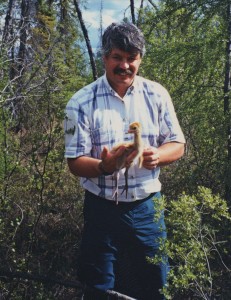
Brian Johns, Canadian Wildlife Service (retired) with whooping crane chick, Wood Buffalo National Park. Brian was recently elected as President, Whooping Crane Conservation Association.
Brian Johns is a retired wildlife biologist with the Canadian Wildlife Service (CWS). He received his Bachelor of Science Advanced degree from the University of Saskatchewan in 1973 and began his career with the CWS that same year. During his time with the CWS Brian conducted research on sandhill cranes, whooping cranes, loggerhead shrike and various songbirds in the grasslands, parklands and boreal forests of Alberta, Saskatchewan and Manitoba.
In 1981 Brian began monitoring whooping crane migration through prairie Canada and participated in the whooping crane radio tracking program. Between 1984 and 1987 he researched habitat use by migrant whooping cranes. Brian began directing the CWS whooping crane program in 1992 and has been involved in research and monitoring studies of Whooping Cranes on the breeding grounds in Wood Buffalo National Park and along their migratory flyway.
Brian’s research has included population monitoring, philopatry, effects of egg collection and the banding of juvenile whooping cranes. Brian has also studied potential reintroduction habitat in Saskatchewan and Manitoba and tracked sandhill crane migration routes from those habitats. He has logged over 1500 hours of aerial surveys over the crane nesting area.
Brian is the past chair of the National Loggerhead Shrike Recovery Team and Canadian Whooping Crane Coordinator. He co-chaired the Canada/United States Whooping Crane Recovery Team from 1995 – 2009. He is the recipient of Nature Saskatchewan’s Conservation Award and the Whooping Crane Conservation Association’s Honor Award and the Jerome Pratt Whooping Crane Award. Brian retired in 2009 after 36 years with the CWS.
Operation Migration On Estimating Whooper Numbers
February 2, 2013Operation Migration’s “In The Field” web page explains, “Debate continues in the Whooping crane world about the methods US Fish and Wildlife Service is now using to count Whooping cranes at the Aransas National Wildlife Refuge.”
“For almost 30 years, retired Whooping Crane Coordinator, Tom Stehn made a direct count of each bird while flying transacts over the refuge. The accuracy of that method was questioned because birds may move between the aircraft passes and been counted more than once.”
“The new system employed since Stehn’s retirement is called ‘distance sampling’. It consists of making multiple parallel survey flights over a large area and applying a formula to the number of cranes spotted to come up with a population estimate.”…
“The concern is that distance sampling is generally used to estimate the size of large populations and there are fewer than 300 Whooping cranes at Aransas. Many feel that a direct count could provide a more accurate number.”
To read the complete article, click on: http://operationmigration.org/InTheField/2013/02/01/controversy-heats-up/
Photographing a Whooping Crane
January 22, 2013Editor’s note: Our members and viewers of our web site often write us about their observations of whooping cranes. Some even send us photos. We always appreciate these. We enjoy sharing some of these submissions with you. We just received some photographs from Carol Mattingly. She also wrote about her experience. Her article is posted below. If you have interesting experiences and photos and would like to have us place them on the web site, please go to our web site whoopingcrane.com . Then click on “Report A Sighting” and fill out the form and click “Send”.
Photographing a Whooping Crane
By Carol Mattingly, Carol Mattingly Photography
Turning left onto a two lane dirt farm road, I edged my car just past an unplowed field and there standing in several inches of water picking at the ground in hopes of finding food was a beautiful adult Whooping Crane. How he could possibly find anything to eat in this field made me wonder. This region had just experienced the most severe drought in recorded history just this past summer. The seeds planted in these fields could not possibly have yielded any crops. Possibly weed seeds and insects were there.
It was a sunny Sunday afternoon and I had made my way to south Indiana just on the other side of a river bridge. The Bottoms is generally what the locals call this area. And after heavy rains the week before, I could see why it is called bottomland. There were large pools of standing water in all of the fields.
And for as far as the eye could see, on this particular Sunday, there were hundreds and hundreds and hundreds of Sandhill Cranes. And standing amongst the Sandhills was this one solitary Whooping Crane. I wondered if it had mated with one of the Sandhill Cranes and would it be traveling with this huge flock of Sandhill Cranes for years to come.
Seeing my first Whooping Crane was a fantastic treat, but getting a fairly decent image of the crane was ever better. I did not want to get too close for fear of frightening the birds. The Whooping Crane stood for some time looking around and I knew that was my opportunity to snap a few images. I love the way the Sandhill Cranes feathers lay across the back of their rump in a poof. But this Whooping Crane’s white feathers lying across his rump was so beautiful. I wonder if he knew he was the star of the show that Sunday. See my photo below:
The Man Who Saved the Whooping Crane
January 13, 2013Preface: After having read Kathleen Kaska’s book, “The Man Who Save the Whooping Crane: The Robert Porter Allen Story”, I needed to know more about this man who, if it hadn’t been for his dedication and perseverance, there probably wouldn’t be whooping cranes today.
While searching for every morsel of information pertaining to the whooping cranes before and during Allen’s time, I often thought of what a wonderful adventure and treasure hunt Kathleen must have had doing her research for the book. I contacted Kathleen to ask if she would like to write a short article outlining her feelings and experiences while researching “The Man Who Saved the Whooping Crane”. Immediately, she responded with “yes” and that she would love to. Below is an account of her adventures, which she has graciously written for us.
Thank you, Kathleen for sharing the life of Robert Porter Allen and your adventures of researching and writing the book.
Pam Bates, Whooping Crane Conservation Association ———————————————-
The Man Who Saved the Whooping Crane: The Robert Porter Allen Story
by Kathleen Kaska
By the time I began writing about the life and adventures of Robert Porter Allen, several decades had passed since he traipsed through the Canadian wilderness in search of the whooping crane’s last nesting site.
I first became aware of Allen’s work while designing an environmental/ecology unit for my
seventh-grade science class. The school librarian provided me with a National Geographic video about the efforts that had been made to save the whooping crane from extinction. The video briefly touched on Allen’s contributions, but it was enough to peak my interest. A few weeks later, I headed for the Texas coast to see the cranes on their wintering grounds at the Aransas National Wildlife Refuge. I’ll never forget that cold morning when I stood on the deck of the Wharf Cat tour boat gazing at those majestic birds through my binoculars—they simply took my breath away and at that moment I, too, wanted to make a difference in the whooping crane’s survival.At the time, I was also writing for Texas Highways magazine. When I returned home, I fired off a query to the editor, offering to write a story about Allen and the plight of the cranes. While researching the article, I realized that Allen had all but been forgotten. I felt his contribution to the world of ornithology and his story about his efforts to save the whooping cranes were too important to be lost. I decided to turn my research into a book.
Allen died in 1963. Considering all the time that had passed, finding someone who knew him well enough to paint a vivid picture of the Audubon ornithologist seemed an impossible task. I called the Florida Audubon chapter, located at the Tavernier Science Center, and learned that his daughter, Alice Allen, was living in Tavernier. I called her and introduced myself and told her about my plans. A few weeks later, I was on a plane to Florida.
Alice was only a young girl at the time her father had been named the director of the Whooping Crane Project in 1946. She was most generous in sharing her recollections of her father’s work, but I needed a wider perspective. I then visited the Science Center where most of Allen’s correspondences, published articles, photographs, and hand drawn maps are kept. Thanks to resident biologist, Pete Frezza, I even had the opportunity to motor out into Florida Bay to Bottlepoint Key where Allen had conducted his spoonbill research in 1939.
I had enough information to write the book proposal, which I eventually sent to University Press of Florida. By the time I received word of the book’s acceptance, my husband and I were on a two-year across-country retirement trip. Coming along with us on the trip, and taking up too much space in the truck of our car, were my research notes, tapes, and books. Over the next several months, I wrote the book in while on the road.
After it’s publication, I began giving presentations, which I entitled “On the Trail of a Vanishing Ornithologist,” named after Allen’s award-winning book, On the Trail of Vanishing Birds. That road trip provided me with the opportunity to visit sites I was writing about: Allen’s hometown in South Williamsport, Pennsylvania, Cornell University where Allen was enrolled in the early 1920s, Hopper’s Landing in Texas where Allen lived while working on the Aransas National Wildlife Refuge, and what proved to be invaluable, a second trip to see Alice and visit the Tavernier Science Center. Alice had uncovered more photos and information. Dr. Jerry Lorenz, the director of the Audubon Center and Flamingo Research Project and Allen successor twice removed, provided me with Allen’s research journals. These journals not only contained detailed accounts of his research, but also personal information; his feelings about being away from home and missing his family; his frustration with delays in moving forward with the Whooping Crane Project; his views on captive breeding program; anecdotes of his travels, which gave me a greater insight to his charismatic personality and sense of humor.
Most of the locations we visited were on our agenda. However, one particular serendipitous event led to an unbelievable experience. While traveling through Florida just south of Tallahassee, we noticed Wakulla Springs State Park, a hot spot for birding, was only a few miles away. We made a slight detour and upon arrival, checked into the historic Wakulla Spring Lodge for a two-night stay.
That afternoon on the birding boat tour, I met Betty and Lou Kellenberger, wildlife photographers and whooping crane devotees. They told me about the Whooping Crane Festival coming up that weekend at St. Mark’s National Wildlife Refuge. Representatives from Operation Migration (OM) and the International Crane Foundation (ICF) were speaking. That’s all I needed to hear. We added two more nights to our stay so I could attend. Although I missed seeing OM ultralight pilot, Brooke Pennypacker, I met Joan Garland with ICF. I told her about my book and she invited me to tour the ICF in Baraboo, Wisconsin later that year.
Looking at our map and calendar, I realized the Necedah National Wildlife Refuge, the location where OM trains whooping crane chicks to migrate, was nearby and that we’d be driving through the area during the time the Class of 2012 chicks would be training. About a week before we arrived in Wisconsin, I emailed Joan and asked if we could watch one of the training exercises. She made a few phone calls, and on the morning of August 12, my husband and I stood in a bird blind with pilot Richard van Heuvelen and lead technician Barb Clauss, both dressed in crane costumes, as they explained the morning’s training plan. Richard left to revive up the ultralight while Barb prepared to released the chicks. Watching those gangly young whoopers rush out of their pen and take to the air was one of the best moments of my life. I had to choke back tears. My husband, who’d spent years listening to me talk about OM, turned to me and said, “Now, I get it.” There were tears in his eyes, too.”
Visiting these sites, discovering Allen’s journal, and watching those chicks fly was just what I needed to give The Man Who Saved the Whooping Crane: The Robert Porter Allen Story, that special emotional element to transform the book from a mere biography into a true-life adventure story.
The book was released on September 16, 2012. Shortly afterwards, I received word that it had been nominated for the George Perkins Marsh Award for Environmental History.
Here’s an excerpt of the book:
It was April 17, 1948 in the early hours of a muggy Texas morning on the Gulf Coast. The sun at last burned away the thick fog that had settled over Blackjack Peninsula. The world’s last flock of wild whooping cranes had spent the winter feeding on blue crab and killifish in the vast salt flats they called home. During the night, all three members of the Slough Family had moved to feed on higher ground about two miles away from their usual haunt. The cool, crisp winter was giving way to a warm balmy spring, the days were growing longer, and territorial boundaries were no longer defended. Restlessness had spread throughout the flock.
As Robert Porter Allen drove along East Shore Road near Carlos Field in his government issued beat-to-hell pickup, he spotted the four cranes now spiraling a thousand feet above the marsh. He pulled his truck over to the roadside and watched, hoping to witness, for the first time, a migration takeoff. One adult crane pulled away from the family and flew northward, whooping as it rose on an air current. When the others lagged behind, the crane returned, the family regrouped, circled a few times and landed in the cordgrass in the shallows of San Antonio Bay. It was Allen’s second year at the Aransas National Wildlife Refuge. He had learned to read the nuances of his subjects almost as well as they read the changing of the seasons.
In the days preceding, twenty-four cranes left for their summer home somewhere in Western Canada, possibly as far north as the Arctic Circle. This annual event, which had been occurring for at least 10,000 years, might be one of the last unless Allen could accomplish what no one else had. The next morning when Allen parked his truck near Mullet Bay, the Slough Family was gone, having departed sometime during the night. That afternoon, he threw his gear into the back of his station wagon and followed.
THE MAN WHO SAVED THE WHOOPING CRANE: THE ROBERT PORTER ALLEN STORY—September 2012: University Press of Florida
Whooper Nesting Grounds Located (History)
January 2, 2013****History Briefs compiled by Whooping Crane Conservation Association****
Editor Note: For many years no one knew exactly where whooping cranes nested. Until 1954 whooping crane interests only knew that the birds migrated from “somewhere” in Canada to the Texas Coast. Crane interests had watched as the whooper population declined to 16 individuals in 1941. Pressures were brought on government agencies to protect and manage the birds. It was important to locate the whooper nesting habitats so these essential areas could be protected. In 1954 the whooping crane nesting area was finally located. The story is an interesting part of history. Whooping Crane Conservation Association member Pam Bates researched the literature and came across an article published in “Wild Lands Advocate” that tells the story. This is a follow-up to another article on our web page published on December 23, 2012. Click on the following link for the related story: https://whoopingcrane.com/whooping-cranes-from-despair-to-hope-to-progress/
DISCOVERY OF THE NESTING GROUND OF THE WHOOPING CRANE *
by Dr. W. A. Fuller
I have received a lot of credit for the discovery in 1954 of the only whooping cranes in Canada, but if it hadn’t been for the fire and an observant forester named George Wilson, I might never have gone out to identify the birds. The last nest of a whooping
crane had been seen in about 1926 in Saskatchewan. Members of the U.S. Fish and Wildlife Service (USWS) and others had searched from central Saskatchewan to the delta of the Mackenzie River without success. The USWS was interested because whoopers migrated to Texas.In 1945 I spent the summer working on fish in Lake Athabasca. At the end of the summer I decided that I would never return to the north. However, in 1946 I signed up to spend the summer at Great Slave Lake. The following winter I put together all the data that had been gathered over several years on the “Inconnu” (Stenodus leucichthys) and submitted the result as my masters thesis for the University of Saskatchewan. Convocation took place in early May.
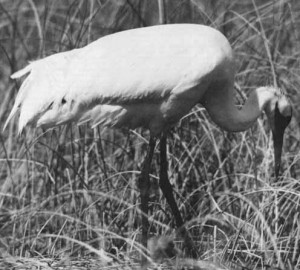
Whooping crane. (From a 1982 Hinterland Who’s Who brochure on the Whooping Crane written by E. Kuyt and published by the Canadian Wildlife Service)
A few days after the ceremony, I turned 23, and on the last day of May I married the young lady who is still my wife. I had previously applied for one of two jobs advertised by the federal government, and I was approved for the one based in Fort Smith, NWT. I found the north gets under your skin, and my wife Marie and I landed in Fort Smith on June 5. My duties centred on mammals in the south half of the Mackenzie District and in Wood Buffalo National Park (WBNP), part of which is in Alberta.In those days, the United States sent a bird guy, Bob Smith, and an assistant down to the Arctic Ocean. They flew out of Fort Smith for two or three days, and I usually took them up on their invitations to go on their sorties. Bob was a great guy, as well as a good pilot and a good bird man. Although waterfowl were the main target, they kept their eyes open for other birds, such as whooping cranes. As late as 1954 they had not made a sure discovery of whoopers, although on an earlier flight with them, one thought he had spotted a crane, but by the time Bob swung the plane around, whatever had been seen had disappeared.
In June 1954, a fire broke out in the northern part of Wood Buffalo Park. On June 30, the fire crew radioed to Fort Smith that one of their pumps was out of order. The forestry guy, George Wilson, went out to the site of the fire in a whirlybird piloted by Don Landells. I was in my office around 4:00 p.m. when a message came in from the plane to the effect that George and Don had seen a few big white birds, which they suspected were whooping cranes. Furthermore, Landells was to make another trip on the same route with a new pump, and if Bill Fuller was at the landing spot at 5:00 p.m he. could go back with Don and the pump.
Bill Fuller was at the landing and ready to go at 5:00 p.m. Don took us back on about the same route he had flown earlier, and we did see some large white birds, which were certainly whoopers. There were young birds as well as adults, so there was reason to believe that the nesting grounds were not too far away. I think we saw about nine birds on that first trip. I sent a telegram to the head office in Ottawa later that evening.
Ottawa’s reply the next morning asked me to keep an eye on the birds whenever there was a chance. I made several trips on an ordinary prop plane. On one such trip I counted thirteen birds, which was just over half of the birds (21, I think) counted in the Texas flock at that time.
The Whooping Crane Society and the USWS were very excited about the discovery, and soon there was talk about a ground survey in 1955. Canadian and American scientists would carry it out. However, the Canadian Wildlife Service (CWS) did not want to commit to that until there was proof of nesting, so I was to take a look next spring as early and as often as possible.
In those days, light aircraft landed on skis in winter and on pontoons in summer. The changeover was made in Edmonton in spring and fall, so it was difficult to find tansportation just when I needed it. While our government plane was in Edmonton, I got a ride with a pilot from Yellowknife on his way to Edmonton.I got another ride in a plane owned by the RCMP in Fort Smith. On that flight I saw what could only be a crane sitting on a nest. So the ground survey was on. Robert P. Allen of the National Audubon Society was to lead it. When Allen arrived in Fort Smith, we made one flight over the area so I could show him the location of the known nests.
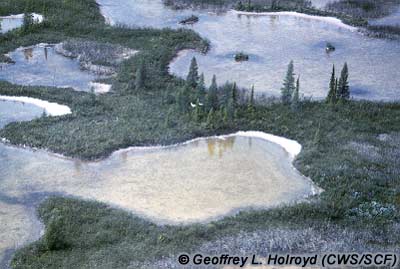
The nesting habitat of the Whooping Crane consists of marshes, shallow ponds, small creeks, and patches of wooded terrain and shrubs. Note two whooping cranes in the center of the photograph.
I made other flights, and I think I found a few more nest sites, but when the ground survey came on, I was at a conference in Alaska. The attempted ground survey is a story of its own.In 1956 I moved to Whitehorse in the Yukon, and Ernie Kuyt of the CWS took over work on the cranes. I had flown over the region of the first sightings a number of times. I had noted the tracks in the mud and searched my brains for a mammal that would make such a trail in the soft mud of the lake bottoms. Big birds never crossed my mind until I saw the cranes there in 1955.So who discovered the nesting ground? Wilson and Landells, who saw the big white birds? Me, because I saw young birds as well as mature birds on my sorties in 1955 and was also the first to see a female on a nest in the spring of 1956?It doesn’t really matter. The important point is that an important nesting ground was found. Each year for several more years, Ernie Kuyt found new nests. The total number of cranes in the Texas/WBNP flock has continued to increase in most, if not all, years since 1955.b
* Published in Wild Lands Advocate, The Alberta Wilderness Association, December 2004 • Vol.12, No. 6, pages 16 and 17.
A WHOOPER NEW YEAR TO ALL
December 27, 2012by Chester McConnell
The Whooping Crane Conservation Association wishes Operation Migration, Florida, Louisiana, International Crane Foundation, U.S. Fish and Wildlife Service and all of our citizen supporters a Whooper Happy New Year. We hope for continued success of the several whooping crane programs. All our combined efforts are essential to help reach the goals described in the International Recovery Plan for the Whooping Crane.
Each private organization and agency has its own program but another very important element to the success of all programs is the tremendous contributions of the private citizens. They assist us in many ways including moral support, contributions of dollars, spreading the message and reporting observations. I want to give recognition to a special group of citizens who observe whoopers and take the time to report their sightings.
The Whooping Crane Conservation Association’s web site includes a “Report A Sighting” section where anyone can let us know about their observations of whooping cranes. We receive reports from many states and several provinces in Canada. While the vast majority of the reports are accurate a few actually turn out to be other large white birds with black wing tips (such as wood storks, white pelicans, snow geese, white ibis) or sand hill cranes. Mostly those who report their sightings have first gone to our web page “Identification” section to convince themselves that they have made a correct identification.
During the past year we have received about 130 reports of whooping crane sightings. About 100 reports involved birds from the Aransas/Wood Buffalo (Western) flock. These reports came from persons in 7 central states and 2 Canadian provinces. And about 30 were sightings of cranes from the Operation Migration (Eastern) program. These reports came from 12 eastern states. If a report seems questionable, we discuss the observations with those who made the report. We believe that about 90 percent of the citizen reports are accurate.
The information received is useful in monitoring the migration of the cranes and determining the locations of some of the individuals at a point in time. Of course some of the cranes are counted more than once because they move often during migration.
An added benefit from the citizen spotters is that some of them send us interesting photos and videos of their observations. We recently received an interesting video and some unusual photos from one of those wonderful people who report their observations of whooping cranes to us. I requested and received permission from Cindy P….. to share with you her video and photos of whooping cranes on her property in Georgia. Her email description of her experience follows:
“Hi Chester,
Of course you may use any of the photos/audio that I shared with you for your website.
On December 17, 2012 at about 7:30 am, one pair of cranes arrived near our 3 acre pond. They grazed and walked about the property and within the next hour another pair of cranes appeared. I grabbed my camera and lenses along with my iphone and headed towards the pond. The four birds casually walked around the pond nibbling here and there. They walked all the way up towards the pine trees where I was able to photograph them using a telephoto lens. I was careful not to get too close to them (you can see in the audio/video how far away they were) so that I wouldn’t scare them off. They continued calling and browsing around for a couple of hours. I was ecstatic!”
“The next two days, the cranes came in and stayed for about thirty minutes before they flew due south. I have to say that they were absolutely gorgeous and I only wish I could have gotten closer. I took a great photo of them flying away. I live about 2 hours from St. Marks, Florida. I think these birds belonged to the flock that migrates that way each year. Hope you enjoy the pictures as much as I did making them. Merry Christmas to all….
Cindy P…. GA
To observe Cindy’s video click on the following: https://www.dropbox.com/s/hei3j65ty422v5k/WhoopCranesCalling.MOV
Several of Cindy’s photos are pasted below. Enjoy.
Being very catious. 12-17-2012
Migrating on south. 12-17-2012
MORE PHOTOS, READ ON:
Now, you can enjoy more whooper photos from more of our citizen reporters by clicking on the fol;lowing link: https://whoopingcrane.com/wp-content/uploads/2012/11/Whooper-photos-8-for-web-article-11-29-124.pdf

